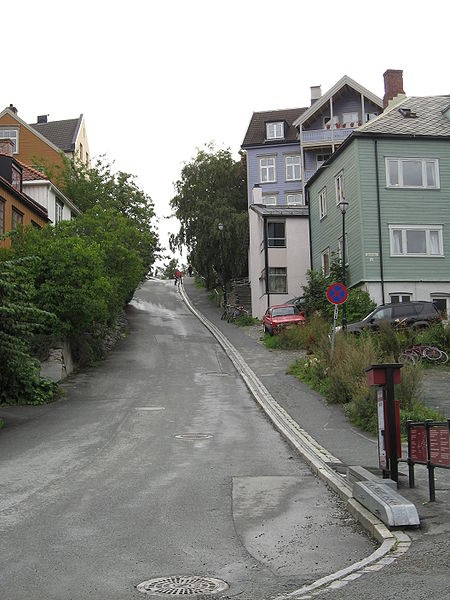The Easiest Way to Bike Up a Hill
You don’t need to be an avid bicycle rider to know that it’s much harder to go up a hill than down it. On the way down, you can coast, riding the brake the whole way. But on the way up, you’ll need to push hard to move yourself and your vehicle to the top of the hill.
Or, you can take the world’s only bicycle escalator.

Pictured above is a section of Brubakken Hill, a steep road in Trondheim, Norway. Bicycling is a common hobby and mode of transportation in the city of about 200,000 people, and a man named Jarle Wanwik was one of them. But for Wanwik, the struggle to get up Brubakken Hill wasn’t one he was willing to deal with on a regular basis. So, according to Atlas Obscura, he engineered himself a solution.
Called the Trampe bicycle lift, it’s the world’s first and to date, only bicycle escalator. You can see it in the image above — it’s the silver box and the attached track seen toward the right of the roadway. (More images can be seen here.)
The Trampe, which was first installed in 1993, works somewhat like a ski slope chair lift, minus the chair (and plus a bicycle, obviously). “To use the escalator,” Slate explains, “a cyclist rides up to the station at the bottom and places her right foot on a small footplate sticking up from the slot running along the curb. The plate then moves all the way up the hill, lifting the rider along with it.” Bicyclists move up the hill at a speed of about two meters per second (about 7 km/hr, or 4.5 miles per hour), which doesn’t sound too fast, but the trip is only about 130 meters. The ride is only about a minute or so, but you don’t have to wait for the rider before you to reach the top. The Trampe has six footplates, allowing multiple cyclists to ride simultaneously.
The Trampe was refurbished in 2013 to meet safety standards (a few people suffered some minor, but avoidable injuries during its first two decades) and renamed the CycloCable, in hopes of giving it a more marketable name. In Trondheim, rides are free, and its use isn’t limited to bicycles; according to Business Insider, “skateboarders use the lift as a welcome break and new parents have relied on the lift to help push baby carriages.”
But despite the bike escalator’s utility and its company’s hope of building them throughout the world, don’t expect to see more of them appear any time soon. While there are a handful of places where bicycling is common, by and large, the mode of transportation works there because the terrain isn’t very hilly in the first place. And for the exceptions, this solution isn’t cheap — per Slate, “the CycloCable costs about $2,800 per meter to install” and that doesn’t include upkeep. Unfortunately, that is much more than most municipalities want to invest in making biking up hill a bit easier. So for now, the Trampe/CycloCable is one of a kind.
Bonus fact: If you order something to be delivered to your home, you risk having it damaged en route. If you’re buying a bicycle this way, that can be a huge problem, as they’re somewhat fragile and many retail for thousands of dollars. Dutch bicycle company Vanmoof knew this all too well; most of their customers bought bikes online, and a few years back, approximately a quarter of their bicycles were damaged during the shipping process. The solution: as CNN reported, Vanmoof began packing the bikes in boxes which had a picture of a TV on the side. Shipping companies and their staff began treating the packages more carefully, and, per the CNN report, “damages plummeted by at least 80%.”
From the Archives: Pedalling to Freedom: Technically, they’re not biking anywhere, but they’re also biking out.
